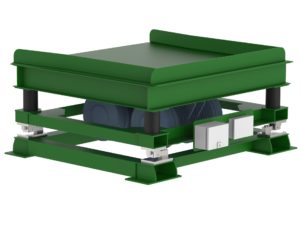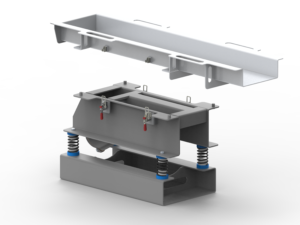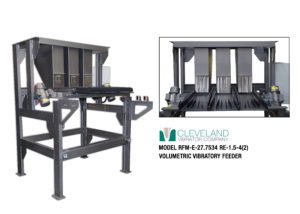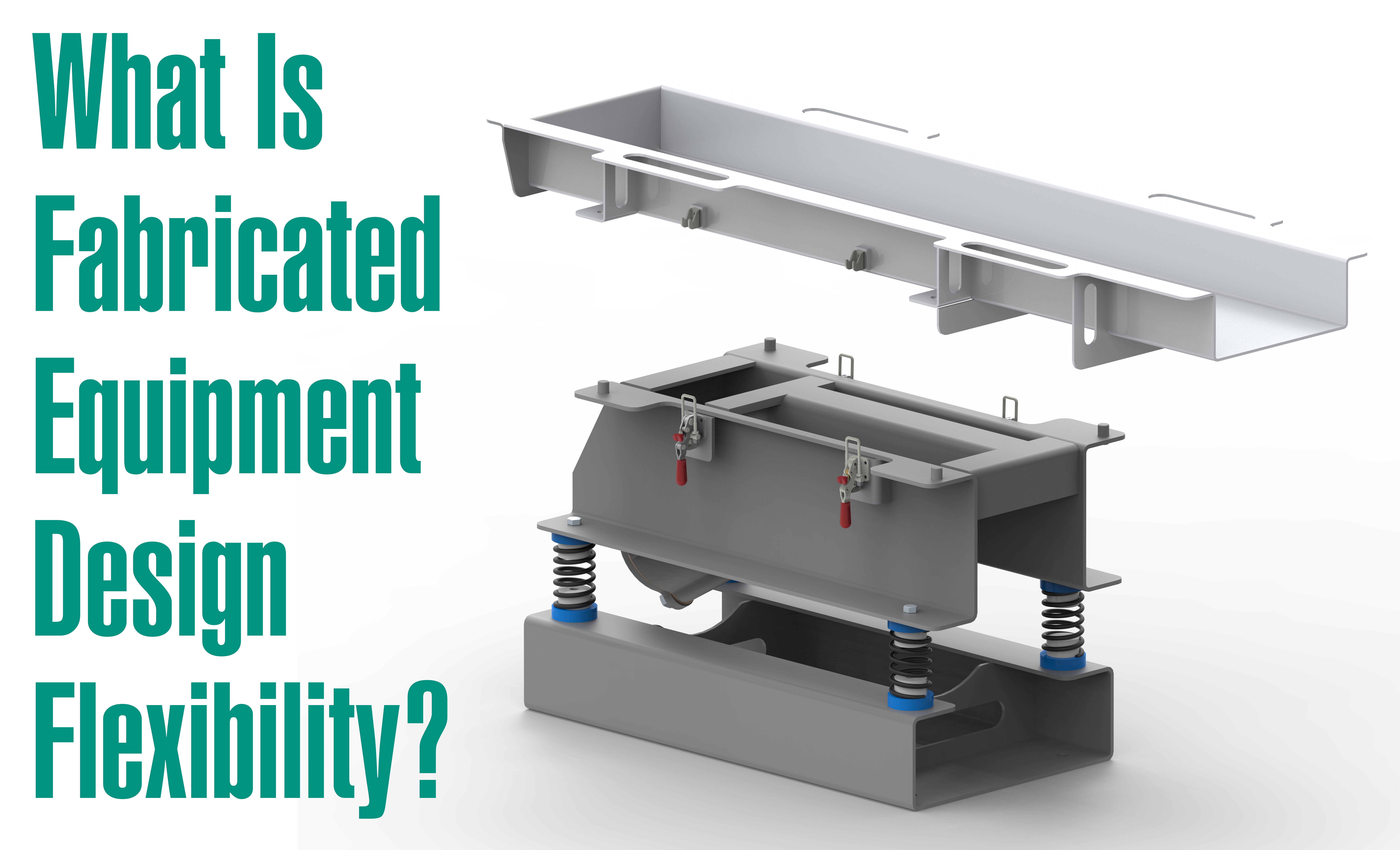Typically flexibility is a good thing, both in business and athletics as well as life in general. For Cleveland Vibrator, flexibility often means having a number of choices available to solve a bulk material problem. Our line of pneumatic vibrators ranges from the small VM-25 piston vibrator to the huge 1900 single impact unit and about everything in between to include ball vibrators, turbine vibrators, air cushion piston vibrators with friction reducing coatings for long life, to a complete line of pneumatic foundry vibrators. If the best solution involves electric vibrators, Cleveland Vibrator has wide range of rotary electric vibrators available with operating frequencies between 900 and 3600 rpms with force outputs from 30 to over 40,000 lbf! That’s some flexibility for sure.
What is fabricated equipment design flexibility?
Designing Fabricated Vibratory Equipment that is built-to-spec requires a large amount of unique options best suited to fit the application and process requirements. Design flexibility is key for a successful install of vibratory equipment into an existent process.
Here are some examples:
- Tray shape options for vibratory feeders include tubular, vee-shaped or flat configurations
- Vibratory tables can settle materials under a bulk bag filler using a flat deck design or be integrated into an automated process that settles product and conveys at the same time
- All vibratory equipment can be electric or air powered dependant on environmental factors and/or power capabilities within the facility
Just having the products available often isn’t enough to provide the best solution to a customer’s application. You need a knowledgeable and experienced sales staff that takes the time to listen to the particulars of the application and is able to recommend the most appropriate product from the company’s offerings. A flexible product line coupled with a flexible technical sales team makes for a good combination.
How much design flexibility is required for vibratory equipment?

Vibratory Compaction Table Designed with Mettler-Toledo Weigh Scales
In the area of fabricated equipment Cleveland Vibrator takes the same approach, listen to the customer and their specific requirements then use our knowledge, experience and products to solve the problem. Some applications are pretty straight forward, “we need to compact 2,500 pounds of bulk popcorn in a Gaylord, oh yea, and we also need to be able to verify the weight of the product.” Our sales team recommended a FWT-4848 RE 24-4(2), vibratory table with load cells to weight the product.
Other applications require a bit more creative thinking and flexibility! A couple of recent applications come to mind where we needed to be flexible to meet the customer’s requirements.
How much flexibility can we achieve when a piece of vibratory equipment requires an easy cleaning design?
One customer reached out to our sales team with the requirement to convey a fine powder used as a colorant. In addition to the basic requirement to move the material they also wanted to be able to easily clean the tray/product contact surfaces prior to changing colors. To clean the tray they wanted the unit designed such that tray could be removed and cleaned in another area, not while fixed to the vibratory unit. In my time at Cleveland Vibrator I think that was a first where the customer wanted to be able to remove the tray, separate it from the device that imparted the vibration into the structure, then reinstall it. Normally the goal is to design a robust, stiff and effectively isolated structure into which we transfer the required vibratory energy to accomplish the task. A removable tray required some flexibility in thinking and design.
Based on the size of the unit and the flow requirements, we decided that this was a good application for a piston vibrator. Once that decision was made the task became to design a rigid framework to which we could quickly attach and detach the tray used to convey the product. Typically we look to use the strength and stiffness of the tray itself as an important part of the design of the unit. For this particular job it was important to design a framework that would be able to support the tray and transfer the vibration but not get the stiffness of the tray involved in the rigidity of the unit.

Vibratory Feeder with Detachable Feed Tray for Powder Processing Application – Cleveland Vibrator Company
With some effort we were able to design a suitable unit, using pins to help mate the framework and the conveying surface tray, we held the tray in place with a number of locking toggle clamps. With the robust frame the tray itself could be lightweight and removable, yet able to move in unison with the framework and move the product. In the end it’s a pretty cool unit, I can’t recall doing another unit similar to this one, this sort of requirement does keep you thinking and flexible.
Prior to the application just discussed we did have a customer looking for a very flexible unit, a hopper feeder application. The unique spin on this application was that the customer wanted to feed material into a number of different sizes and shapes of trays. The widths and lengths of the tray configurations were different but the goal was to feed material onto these trays with one unit. The primary tray was essentially square but had two vertical dividers in the tray. Material fed into the tray couldn’t land on the exposed edge of the divider and down the road the trays might be one third the width of the square tray. Using ‘one big feeder’ to spread the material on the tray wasn’t going to work.
How much flexibility can we achieve when a piece of vibratory equipment has installation space limitations but the requirement to move three materials at the same time?

Volumetric Vibratory Feeder with 3 Tray Design – Cleveland Vibrator Company
After more discussion with the customer and some testing of the product, we decided to make three different feeder trays, each to be supplied the material by its own hopper yet driven by one base frame and one set of rotary electric vibrators. The idea of an adjustable bolt on tray on a base frame was a bit novel; putting three side by side was definitely new. Due to space limitations and trying to be cost sensitive it only made sense to explore this sort of solution. We just didn’t have room to put three compete vibratory feeders side by side and still hit the required centerlines for the square tray and it’s three sections.
As a general rule I really try to stay away from bolting anything on a piece of vibratory equipment, the only exception being the vibrators. Hinged or pivoting parts are a challenge to make sure they don’t rattle or shake free. So the idea of three trays bolted to one vibrating frame was pretty unique. But to make a flexible piece of equipment to meet the customer’s request, it seemed like a good approach.
The final design used two of our smaller rotary electric vibrators, side mounted to a frame structure. The frame was designed with slotted attachment points for the three feeder trays so that they could be adjusted to center on the various sized trays. Once in position the feeder trays are bolted in place and locked to the frame structure. Each hopper used to supply material to its corresponding feeder also had a slotted attachment so it could move with the feeder.
In the end we successfully supplied a unit with three feeder trays yet all driven by a pair of rotary electric vibrators. The customer’s required flexibility to modify the set up to feed material into different trays was accomplished.
Thinking a bit outside the box is required from time to time, as I’ve said before one size doesn’t fit all. Our customers are faced with a wide range of material handling challenges; Cleveland Vibrator has both the diverse product offering and technical expertise to assist in solving those challenges.
Share this blog post:
Follow us:


